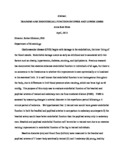Training and Endothelial Function In Upper and Lower Limbs
Author
Bires, Anna Kate
Abstract
Cardiovascular disease (CVD) begins with damage to the endothelium, the inner lining of the blood vessels. Endothelial damage occurs as early as childhood and is associated with risk factors such as obesity, hypertension, diabetes, smoking, and dyslipidemia. Previous research has documented that exercise enhances endothelial function in individuals of all ages, but there is no consensus in the literature as to whether this improvement is seen systemically or is localized to the exercised limb. It is well known that endothelial function is not homogenous throughout the body, due to differences in limb blood pressure when standing, which can be as high as 65 mmHg. The purpose of this study was to evaluate endothelial function of the brachial and popliteal arteries of trained and sedentary men via flow-mediated dilation (FMD). FMD is assessed by measuring changes in arterial diameter in the reperfusion period following a 5-minute period of ischemia. We hypothesized that 1) trained men would have greater endothelial function in both the brachial and popliteal arteries in comparison to sedentary counterparts 2) the brachial artery would have better endothelial function than the popliteal artery only in sedentary men. Brachial and popliteal endothelial function will be similar in trained men due to an exercise training improvement in endothelial function of the leg in trained individuals. Baseline diameter (cm) and blood flow (ml/min) were measured in the brachial and popliteal arteries of 7 lower-body aerobically trained (T) and 7 sedentary (S) young, healthy men. A blood pressure cuff was inflated to occlude the artery for 5 minutes. Upon releasing the cuff, diameter and blood flow were measured intermittently for 5 minutes via Doppler Ultrasound to evaluate the vessel's reactive hyperemic response. FMD was calculated relatively, as a percent change from pre-occlusion, and absolutely, as a cm change from pre-occlusion. The data were analyzed utilizing a 2X2 ANOVA and linear regression. Trained men exhibited enhanced endothelial function in comparison to sedentary counterparts when FMD was expressed as a percent change (T brachial=15.12 ± 8.44%; S brachial =8.71 ± 2.57%; T popliteal= 8.35 ± 5.03%; S popliteal 5.24 ± 2.57%; p= 0.029) and as an absolute change (T brachial= 0.06 ± 0.03cm; S brachial 0.04 ± 0.01cm; T popliteal=0.05 ± 0.29cm; S popliteal 0.03 ± 0.02cm; p=0.013). In both groups, the brachial artery had better endothelial function than the popliteal artery (p=0.019). In accordance with the hypothesis, endothelial function was enhanced in trained subjects compared to sedentary controls. However, contrary to our prediction, greater endothelial function was expressed in the brachial than popliteal arteries of both groups. It was concluded that aerobically trained subjects have an improved endothelial function as compared to sedentary subjects in the lower and upper body.
Subject
Date
2013
Citation:
APA:
Bires, Anna Kate.
(January 2013).
Training and Endothelial Function In Upper and Lower Limbs
(Master's Thesis, East Carolina University). Retrieved from the Scholarship.
(http://hdl.handle.net/10342/4198.)
MLA:
Bires, Anna Kate.
Training and Endothelial Function In Upper and Lower Limbs.
Master's Thesis. East Carolina University,
January 2013. The Scholarship.
http://hdl.handle.net/10342/4198.
June 29, 2024.
Chicago:
Bires, Anna Kate,
“Training and Endothelial Function In Upper and Lower Limbs”
(Master's Thesis., East Carolina University,
January 2013).
AMA:
Bires, Anna Kate.
Training and Endothelial Function In Upper and Lower Limbs
[Master's Thesis]. Greenville, NC: East Carolina University;
January 2013.
Collections
Publisher
East Carolina University

